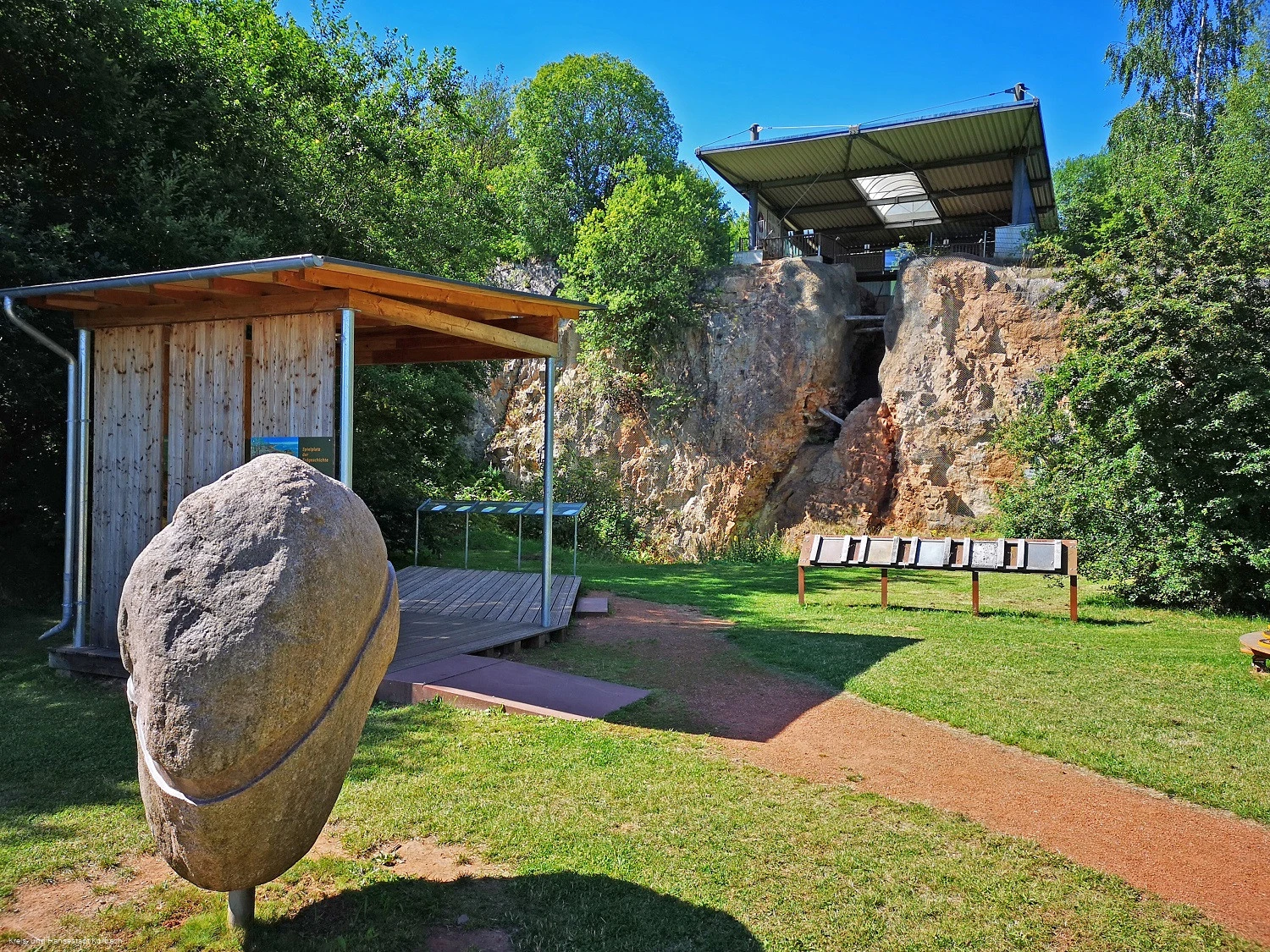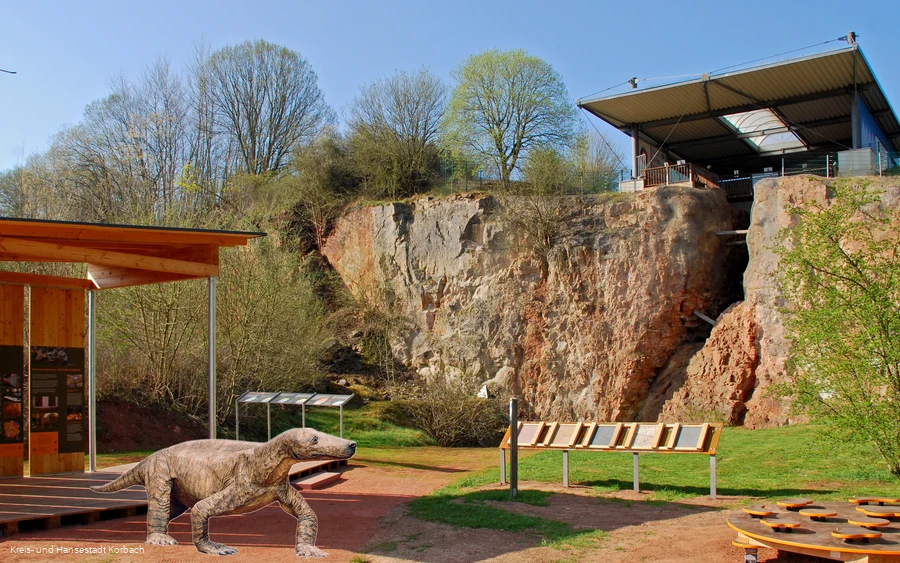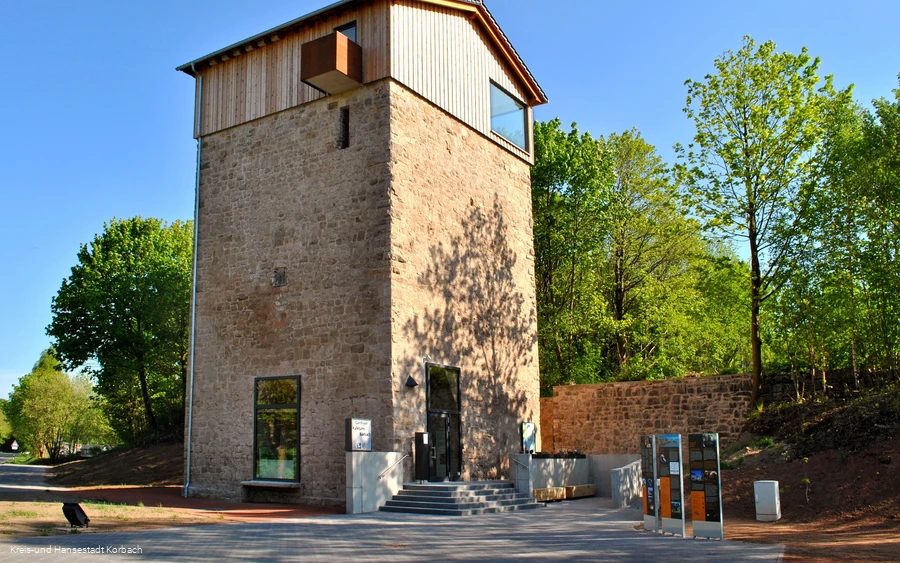- Free admission
Korbach fissure fossil site
Info point
One of the highlights of the GrenzWelten National Geopark is located at the southern entrance to Korbach. The "Korbach Fissure" fossil deposit is one of the world's most important fossil sites of vertebrates from the Permian period and the oldest fossil-bearing fissure in Europe.
Address
Korbach fissure fossil site
Frankenberger Landstraße 22
34497 Korbach
Telephone: +49 5631 53289
Properties:
The fossil deposit was discovered in the mid-1960s by geologist and local historian Dr. Jens Kulick. It was not until 1988 that a lower jaw fragment from the crevice filling could be assigned to the genus "Procynosuchus", a mammal-like reptile that lived in the Upper Permian period around 250 million years ago and is colloquially known as the "Korbach dachshund".
The State Museum of Natural History in Karlsruhe carried out several excavation campaigns between 1990 and 1998, during which a total of around 2500 analyzable bone fragments were recovered. The Korbach finds were the first evidence of Procynosuchus in the northern hemisphere. This is regarded as an indication that all of the Earth's land masses at that time were already united to form the supercontinent Pangaea. Alongside the Messel Pit World Heritage Site, the Korbach Fissure fossil deposit is the most important palaeontological monument in Hessen.
Augmented reality - the Korbach Fissure is interactive!
Augmented reality adds a digital and interactive highlight to the Korbach Fissure. Bring long-gone times and creatures back to life and
make your visit to the Korbach Fissure an experience for the whole family!
family!
All you need is your smartphone or tablet, which you can use to scan the QR codes in the information pavilion directly at the Korbach Fissure. Now you can decide whether you want to look at the "Korbach dachshund" in a 3D simulation or prefer to experience the formation of the Korbach Fissure up close in a 2D simulation.
Formation of the fissure:
Around 260 million years ago, during the age of the Zechstein, there was a large inland sea in northern Central Europe. It was supplied with seawater from the open ocean in several phases and evaporated again due to the desert-like climate. In the process, it left behind typical rock sequences of limestone, sulphates (gypsum and anhydrite) and salts.
At that time, the Korbach area was located in the western coastal region of this Zechstein Sea on the eastern edge of today's Rhenish Slate Mountains. At the time of the first marine advance, the coast was lined with a belt of vegetation that provided good living conditions for the land-dwelling reptiles and served as a food source for them.
During the first phase of evaporation, the sea retreated in the increasingly hot and dry climate. As a result of the climatic changes, the vegetation decreased, depriving the reptiles of their food source and causing the herbivores to migrate. The carnivores also disappeared with them. Many animals died and their skeletons became embedded in the sands of the desert-like landscape on the edge of the mountains.
Some time later, during rainy seasons, the sedimentary cover, which was no longer protected by vegetation, was washed down with the preserved skeletons and deposited again in the plain in front of the mountains, which was formed from the limestones of the Zechstein. In the meantime, fissures had formed in these limestones, presumably due to mechanical events such as earthquakes, which were filled with the sediment and the bones and bone fragments they contained, which had been crushed during transportation.
A little later, further erosion material from the mountains covered the landscape before the Zechstein Sea advanced further into the Korbach area and finally covered the fossil-filled fissure with new limestone deposits.
Access information:
The quarry with information pavilion is accessible free of charge.
The protective roof over the Korbach fissure can only be visited as part of a guided tour:
- April-October, Sunday 11:15 a.m.
- July+August additionally Monday 16:30
The guided tours cost €4/€2 (adults/children/youngsters), children under 6 and guests with MeineCardPlus have free admission.
Admission to the neighboring GeoFoyer Kalkturm Korbach is €1 per person. Opening hours: March-October Tue-Sun+holidays 11-16:30, November-February Tue-Fri 14-16:30, Sat+Sun+holidays 11-16:30.
Prices
Directions
Frankenberger Landstraße 22, 34497 Korbach Parking directly on site.


